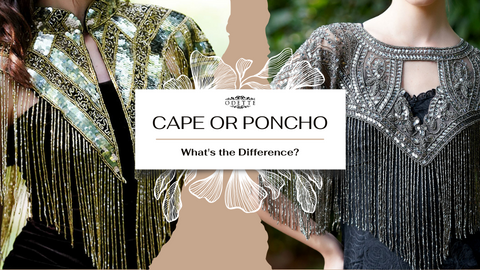Cape or Poncho: What's the Difference?

Capes and ponchos are timeless, versatile garments that add a touch of elegance and warmth to any outfit. While they may seem similar at first glance, there are distinct differences that set them apart in terms of design, origin, versatility, and styling. At Odette, we're all about offering a variety of capes to elevate your style, and in this blog, we'll delve into the nuances of capes and ponchos to help you make an informed fashion choice.
Origin and History
To truly understand the differences between capes and ponchos, it's essential to delve into their origins. Both garments have a rich history dating back centuries.
Capes: Capes have a long and illustrious history, with roots tracing back to ancient civilizations like the Greeks and Romans. These early capes were often made of animal hides or heavy fabrics, serving as functional garments for protection against the elements. Over time, capes evolved into elegant accessories, becoming staples in aristocratic European fashion during the medieval and Renaissance periods. They've remained a symbol of sophistication ever since.
Ponchos: Ponchos have an equally fascinating history, primarily originating from the indigenous cultures of the Americas. Native American tribes, such as the Navajo and the Inca, were among the first to craft ponchos from materials like wool and alpaca. Ponchos served as practical clothing, offering protection from the harsh weather conditions of the Andes and North America. With time, ponchos made their way into the mainstream fashion scene and became synonymous with a rustic, bohemian style.
Design Distinctions
Capes and ponchos differ significantly in their design, which impacts their appearance, functionality, and how they complement various outfits.
Capes: Capes are usually sleeveless and open at the front, with a front closure like buttons, clasps, or a tie at the neck. They drape over the shoulders and cascade down the back, offering a regal and elegant appearance. Capes often feature structured silhouettes and can be made from a wide range of materials, from wool to silk, allowing for a more tailored and fitted look. Capes often have arm slits for added functionality.
Ponchos: Ponchos, on the other hand, are typically one-piece garments with a hole in the center for the head. They have a loose, unstructured shape that drapes over the body without any specific front or back. Ponchos are designed for ease of movement and are often made from natural, rustic materials like wool or cotton. They are known for their relaxed, bohemian style and their ability to provide full coverage and warmth.
Versatility
When it comes to versatility, capes and ponchos have different strengths, making them suitable for various occasions and style preferences.
Capes: Capes are renowned for their elegance and sophistication. They can effortlessly transition from casual to formal wear, making them a versatile addition to any wardrobe. A well-tailored cape can be paired with a dress for a formal event or draped over jeans for a chic yet casual look. They're perfect for adding a touch of refinement to your outfit.
Ponchos: Ponchos excel in providing warmth and comfort. Their relaxed fit makes them ideal for casual, everyday wear. You can throw on a poncho over a sweater and jeans for a cozy winter look or wear one as a statement piece with your favorite boho dress. Ponchos are often preferred for their practicality and ability to layer over other clothing.
Styling Tips
Now that you're aware of the key differences between capes and ponchos, let's explore some styling tips to make the most of these fashionable garments.
1. Cape Chic: For a polished, sophisticated look, pair a cape with tailored pants or a pencil skirt. Opt for monochromatic outfits to create an elongated, streamlined appearance. A statement waist belt can accentuate your waist line and add a touch of glamour.
2. Poncho Perfection: When wearing a poncho, keep the rest of your outfit simple to let the poncho be the center of attention. Skinny jeans and ankle boots work well with ponchos for a casual ensemble. To emphasize your shape, cinch the poncho with a belt at the waist for a more defined look.
3. Material Matters: Pay attention to the fabric of your cape or poncho. Wool and cashmere capes are ideal for colder seasons, while lighter fabrics like silk, net and chiffon are perfect for spring and summer. Ponchos in wool or alpaca are perfect for keeping warm in the winter, while lightweight cotton or linen ponchos are ideal for the warmer months.
Conclusion
In the world of fashion, capes and ponchos are distinctive in their origin, design, versatility, and styling. While capes exude elegance and sophistication, ponchos offer warmth and comfort in a relaxed, bohemian style. Both these garments have unique qualities that can enhance your wardrobe, and your choice depends on the occasion and your personal style.
At Odette, we understand the allure of capes and offer a variety of styles to cater to different tastes. So, if you're seeking a timeless cape to add a touch of sophistication, embrace the charm and versatility of these garments and make a statement with Odette's exquisite selection of embellished capes. Elevate your style, stay trendy, and make a lasting impression with the perfect cape from our collection.
Your wardrobe will thank you for it.





Leave a comment